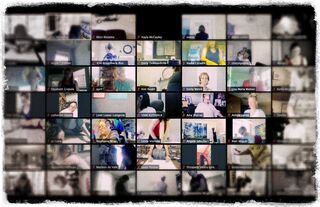Proxemics
Evolution of the Social Brain During Physical Distancing
Proxemics and the concept of social engagement are changing.
Posted August 31, 2020 Reviewed by Ekua Hagan

Recently, I had a vivid memory of what we might now call a “pre-pandemic” time when physical distancing was not yet a thing. It was triggered by hearing a piece of music that I often play at the start of lectures. Suddenly, I saw myself standing at a podium in a ballroom in January in front of 1,000 people, surveying the audience, and getting ready to speak. In the front row, there was an old friend who made the journey from out of state to hear me speak and spend time with me.
I recalled the conference host who introduced me, and I even felt my usual flush of embarrassment in listening to the credentials and accomplishments. We gave each other a firm hug, and I looked out at the crowd, some looking at me, others disengaged, still waiting for their coffee to take hold. And some checking their cellphones, caught up in work or dramas miles away from the venue.
The event I recall was months ago, and since then, I have become a regular part of the everyday phenomena of Zoom meetings and webinars. Now I give keynotes to audiences that I rarely see except when individuals are allowed to appear in the question-and-answer portion of the presentation. It does not matter to me if there are 30 people or 3,000; my sense of energy in the “Zoom Room” is no longer a part of the pressure to perform or the dynamics of the experience. When I first transitioned to these virtual events, I often imagined what that audience would look like seated in a hotel or conference center. Now I have come to expect that I will just begin to talk to a screen where, at best, I will see a host and likely no one else.
I am conscious that my social brain has now subtly evolved, including the proxemics it once knew in a human-to-human world. Proxemics is a concept that refers to the amount of distance that we are comfortable putting between ourselves and others. On average, Americans prefer an 18-inch distance between themselves and others during a casual exchange, but proxemics preferences vary from culture to culture.
There are also various forms of personal space, including intimate, personal, social, and public. In response to the pandemic, my social brain has recalibrated personal space due to self-preservation and health recommendations. And like everyone else who regularly uses the screen to communicate safely, my personal sense of proxemics is being revised in ways I will only realize once physical distancing is lifted.
There are other noticeable changes emerging, ones that I now regularly experience within virtual audiences. One involves social engagement, a concept proposed by Stephen Porges as how safe we feel when in the presence of others. Undoubtedly, the experience of presence is changed now that we are meeting through screens and virtual platforms.
For some, an unexpected evolution has manifested—a deepened feeling of safety in one’s body and mind while in a screen-to-screen encounter. I first noticed this in telehealth patients whom I had once seen in a clinic and now in virtual sessions. Their sense of relaxed alertness is palpable even over a Zoom meeting. In the online training I conduct, the level of participation is noticeably different in individuals who were once uncomfortable talking or even asking a question in front of a human-populated room. People who never contributed due to social anxiety now speak with confidence. The proxemics of a telecommunications environment has finally allowed their social brains to find the calm and courage to participate without hesitation and often with newfound authority.
Earlier this year, my colleague, neurodevelopmental psychiatrist Bruce Perry, commented to me that the brain knows the telehealth environment is not the same as human-to-human contact. But during some Zoom meetings, participants are starting to challenge this observation. After a group online expressive arts experiential, one attendee in the gallery of faces excitedly proclaimed: “I loved the session today. I could feel everyone’s energy while making sounds and art together. It was so lovely.” It seems that the social brain, despite distance and separation, may be adapting or evolving, if only to convince us through imagination that we are together.
While our social brains may be evolving, like music that evokes wonderful memories of experiences and events, I still have an insatiable longing to once again entertain all my senses. There are eyes I long to gaze into directly and arms and bodies I want to entangle with myself once again. At the same time, I know that the proxemics and rules of social engagement are changing in my patients and students. And while I don’t want to admit it, I will eventually discover how my social brain has changed too.


